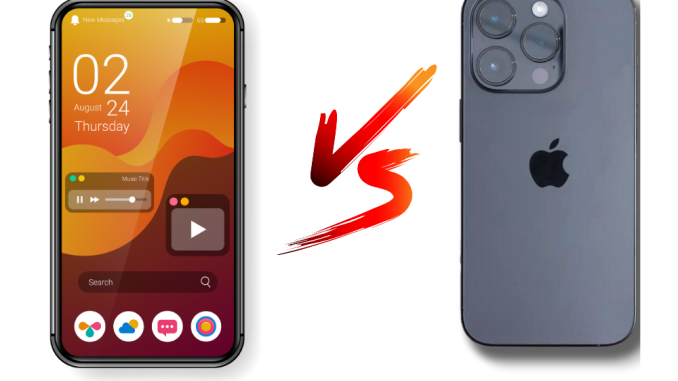
Mobile operating systems have come a long way since their inception, with iOS and Android leading the charge. In this blog post, we’ll delve into the evolution of these two dominant platforms, comparing their journeys, innovations, and the impact they’ve had on the tech world.
The Birth of Mobile Operating Systems
iOS: The Pioneer of the Modern Smartphone Era
In 2007, Apple revolutionized the mobile industry with the introduction of the iPhone, running on iOS. Steve Jobs’ vision of a sleek, intuitive, and powerful mobile operating system set the stage for the modern smartphone. iOS was praised for its user-friendly interface, seamless integration with Apple’s ecosystem, and a robust App Store that offered a plethora of applications.
Android: The Open-Source Contender
Shortly after iOS, Google launched Android in 2008. Unlike iOS, Android was open-source, allowing manufacturers to customize the OS for their devices. This flexibility led to a diverse range of Android devices, from budget-friendly phones to high-end smartphones. The open nature of Android fostered innovation and competition, which drove rapid advancements in mobile technology.
Key Milestones in the Evolution of iOS and Android
iOS Milestones
- iOS 2 (2008): Introduction of the App Store, revolutionizing how applications are distributed and monetized.
- iOS 5 (2011): Launch of iCloud, enhancing the seamless integration across Apple devices.
- iOS 7 (2013): Major design overhaul with a flat, minimalist design language.
- iOS 10 (2016): Significant updates to Siri, making it a more robust virtual assistant.
- iOS 14 (2020): Introduction of widgets and App Library, adding more customization options for users.
Android Milestones
- Android 1.5 Cupcake (2009): First major update, introducing on-screen keyboards and third-party app widgets.
- Android 2.2 Froyo (2010): Performance improvements and support for tethering and portable hotspots.
- Android 4.0 Ice Cream Sandwich (2011): Unified UI for phones and tablets, and enhanced multitasking.
- Android 5.0 Lollipop (2014): Material Design, offering a more cohesive and visually appealing interface.
- Android 10 (2019): System-wide dark mode and improved privacy controls.
iOS vs. Android: Key Differences
User Experience
iOS is renowned for its smooth, consistent user experience across all Apple devices. The closed ecosystem ensures that hardware and software are tightly integrated, leading to optimized performance and stability.
Android, on the other hand, offers greater customization and flexibility. Users can tweak almost every aspect of their device, from the home screen layout to the underlying system settings. However, this can sometimes lead to fragmentation and inconsistent user experiences across different devices.
App Ecosystem
Both iOS and Android boast vast app ecosystems, but they differ in certain aspects:
- iOS: Known for high-quality apps, often debuting on the App Store before making their way to Android. Developers tend to prioritize iOS due to its higher monetization potential.
- Android: Offers a larger variety of free apps and allows more freedom for developers to publish their applications. However, this can sometimes result in lower quality control compared to iOS.
Security
iOS is generally considered more secure due to its closed nature and stringent app review process. Apple’s tight control over its ecosystem minimizes the risk of malware and security breaches.
Android’s open-source nature makes it more susceptible to security threats. While Google has made significant strides in improving security with features like Google Play Protect, the higher degree of customization and less regulated app stores can pose risks.
The Impact of iOS and Android on the Tech World
The rivalry between iOS and Android has driven significant innovation in the tech industry. Features like high-resolution displays, advanced camera systems, and powerful processors have become standard, pushing the boundaries of what smartphones can do.
Moreover, the competition has led to more affordable devices, making smartphones accessible to a broader audience. Both platforms have also played a crucial role in the rise of mobile internet usage, influencing how we consume content, communicate, and perform everyday tasks.
The Future of Mobile Operating Systems
Looking ahead, both iOS and Android are poised to continue their evolution with a focus on artificial intelligence, augmented reality, and enhanced user privacy. Apple’s emphasis on ecosystem integration and premium experiences will likely persist, while Android’s flexibility and wide device support will continue to drive its global adoption.
In conclusion, the evolution of iOS and Android has been a fascinating journey marked by innovation, competition, and significant technological advancements. As these platforms continue to evolve, users can expect even more exciting features and capabilities in the years to come.
By understanding the history and key differences between iOS and Android, we can better appreciate the unique strengths and contributions of each platform to the tech world. Whether you’re an Apple aficionado or an Android enthusiast, one thing is certain: the future of mobile operating systems is bright and full of potential.
Leave a Reply